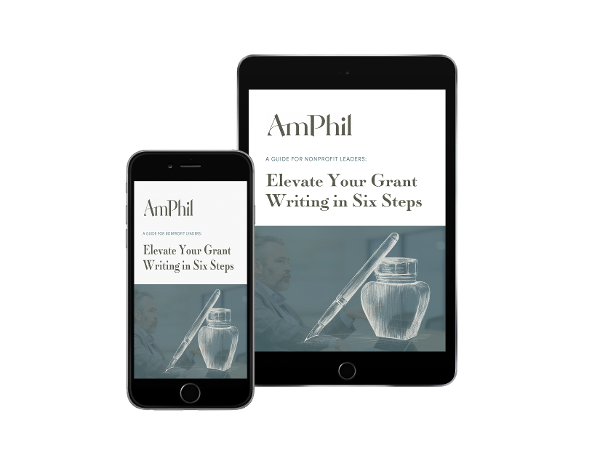
Writing a grant proposal for a foundation or a major donor can take hours, even days. To make sure this time has been well spent, there are six things you should be sure to do:
Include a Strong Cover Letter and Executive Summary
Most foundations are overwhelmed with proposals, and many smaller foundations—especially family foundations—have no dedicated staff to wade through them. Unless you have been specifically invited to apply, the foundation representative who reviews your proposal will likely be looking for a reason to reject it. You will make that decision easier if you do not immediately clarify who you are, what you are asking for, and why.
Your cover letter and executive summary should accomplish this goal, making a strong, concise case for support and including important details such as the amount and purpose of your request.
It’s worth remembering that, oftentimes, the people ultimately making grant funding decisions—the foundation’s board members—never see your full proposal. Instead, they may receive a summary of the proposal prepared by foundation staff, which is combined with other request summaries into a board book. Sometimes, the proposal’s cover letter or executive summary is included along with this summary—this is another reason to make these elements count.
Give Context for Your Request
Many proposals dive straight into nuts and bolts—what you will do and when—without first answering the critical questions, “Why are we doing this? Why should you care?”
You need to make sure you’re giving adequate background for your request. Take a step back and set the scene. What’s the problem you’re addressing? Why is it important? How is your organization well-suited to addressing said problem? Are there other organizations involved in similar work? If so, how is your work different?
If you’re unsure of whether you’re answering these questions well, try giving the proposal to someone outside of your organization who’s relatively unfamiliar with your work. Does it make sense to them? Do they care about what you’re pitching? Is the solution you’re proposing connected to the problem? Are there significant gaps in your proposal, or questions that you haven’t answered? Get candid feedback and modify the request accordingly.
Customize the Request to the Foundation’s Requirements
This starts with your research process. Have you looked at the foundation’s giving history, website, and other resources to see if your organization’s work falls within the foundation’s giving areas? If so, let your application reflect that you’ve done your homework by mentioning specifics about the foundation’s mission and giving and how you might fit into that picture.
And if a foundation has given you application forms or guidelines, don’t just ignore them and do your own thing. That’s just annoying and gets you off on the wrong foot from the get-go.
Here at AmPhil, we like to use the acronym ATFQ: Answer the Frickin’ Question! Follow the guidelines carefully and ATFQ—and make it abundantly clear that you’ve done so.
Pass the Straight-Face Test
It’s okay to accentuate the positive but, please, don’t just make things up. Don’t come up with a project out of left field for which you have zero qualifications just because you think a foundation might fund it. Don’t include everything plus the kitchen sink in your project budget.
Likewise, don’t shoot yourself in the foot by dramatically underestimating the time and budget needed to execute your project. Have an appropriate sense of humility in your approach and don’t promise what you can’t deliver.
If the grant is awarded, remember that you’ll probably have to report back on how well you’ve done and how you’ve spent the money, so make sure that you’re setting appropriate, achievable, realistic goals at the front end so you’re not setting yourself up for failure down the road.
Pay Attention to the Details
Few proposals are literary masterpieces, and the proposal genre can be constraining. It is nevertheless vital to invest in good writing, as it can greatly help or hinder your cause. If you’re not a talented writer, it’s worth finding someone who is—even if you have to outsource this task to capture your vision in a clear, concise, compelling way.
Be sure to proofread your materials thoroughly before sending to ensure that the text is free of typos and formatting gaffes, and that key information—such as the funder’s name!—is accurate.
Pay attention to the visuals, too. The design of your proposals should convey a sense of competence and professionalism, highlighting the content and making it easy to skim and digest. That said, don’t go overboard with your design. It should look polished, but not slick. Use headers, bullets, and other visual cues to differentiate sections and make navigation clear. Use legible, grown-up font (pro tip: not comic sans in 8 pt.). Include a list of the requested attachments and actually include them.
Remember that People Run Foundations
Foundations aren’t staffed by ghosts in a machine—people run them. They may be run by the donors themselves, by family members, or by professional staff, but they’re still people.
Think about this as you approach them and cultivate your relationship. As with any human relationship, you want to be polite, to listen, to be honest, to remember what they like and dislike, to show appreciation, and not take their support for granted.
This means communicating effectively. Ask questions if you’re confused. Say, thank you if they give you a grant. Don’t talk to them only when you want something. Take note of proposal and report deadlines and be timely. If something goes awry on a project, don’t wait until your report is due to say that things didn’t work out—contact your funder and figure out an alternative path forward.
Many foundations are flooded with proposals. Following these tips will help ensure that your nonprofit’s proposal stands out for its quality and gets your funding relationship off on the right foot.
About the Author
 Liz Palla is an Executive Partner and Chief Talent Officer at AmPhil. Liz also works with donors and nonprofit organizations around the country on projects, including strategic assessment and planning, philanthropy advising, and planned giving program implementation.
Liz Palla is an Executive Partner and Chief Talent Officer at AmPhil. Liz also works with donors and nonprofit organizations around the country on projects, including strategic assessment and planning, philanthropy advising, and planned giving program implementation.
Before joining AmPhil, Liz served as a senior program officer at the William E. Simon Foundation, where she helped review and make recommendations on funding proposals, evaluate organizational effectiveness, and maintain foundation operations. Previously, she worked at a nonprofit dedicated to supporting independent college newspapers on campuses around the country. She graduated from Gonzaga University, where she studied foreign languages, literature, and philosophy. She and her husband live in California’s Bay Area and have five children.
Connect with Liz on LinkedIn here or contact her anytime at lpalla@amphil.com.


